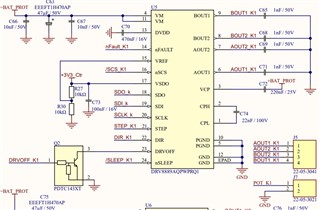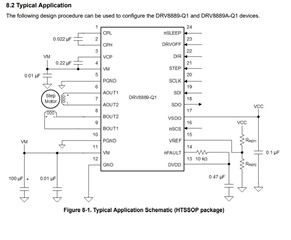Hello there,
I am working on a project where we use DRV-8889A-Q1 to drive a unipolar 6 wires stepper motor RS pro 1805279,
I have connected the main coils terminals of the motor to the motor driver,
DRVOFF = 0v
nSleep = 3.3V
VCP = 12V
Vm = 12V
PGND = 0V
DVDD = 0V
VREF = 1.6V
SSI clk frequency = 400Khz
1) in the code I do enable the device with the logic of nSleep and DRVOFF
2) I configure the microstepping to 1/256 microstep
3) I enable stall detection
4) then I set DIR pin logic high
5) enable PWM signal to "STEP" pin with frequency 166Hz (calculated from the equation in the datasheet given motor speed = 50RPM)
6) enable stall learning bit in CTRL5 Reg bit 5
7) then I read it again until its equal to zero which means learning is done
8) Stop PWM signal.
9) and check on STL_LRN_OK bit
the problem is the motor does not move at all, I have even tried to enable its outputs with the nSleep and DRVOFF pin and input a pwm signal to the step pin depending on the default values in the registers without any SPI commands but also there is no output at all, what am I missing.
attached the pin connections



